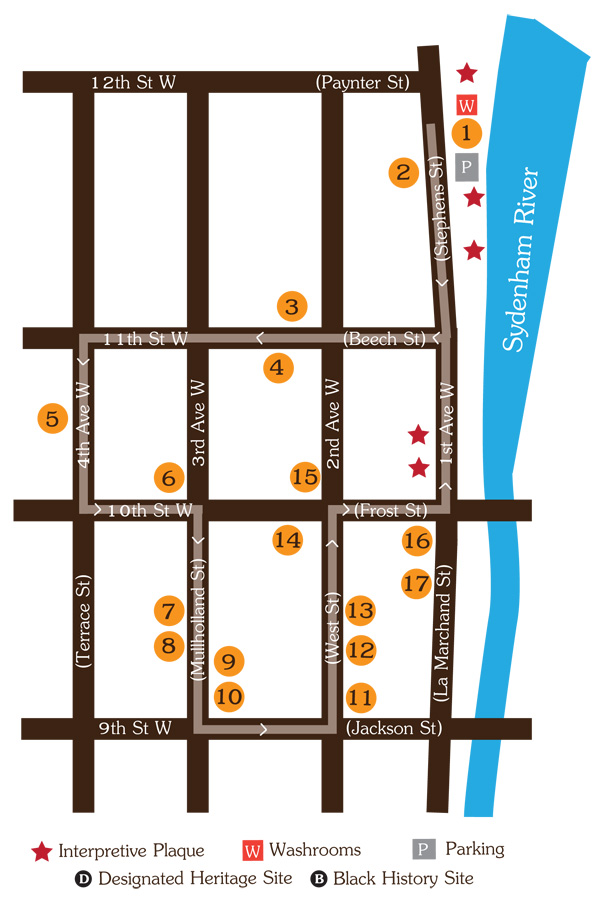

This station was built in 1932, replacing the Grand Trunk Station of 1894. Passenger service ended in 1970, freight service in 1986. The tracks were removed in 1995, except for this short strip. The station now houses the Marine & Rail Museum, and the City's Visitor Information Centre.
This site was home to a machine shop and foundry begun in 1856 by Scottish immigrant William Kennedy. It reached its zenith during WWII as Black Clawson Kennedy, where propellers for Canadian-built ships were cast. It was one of a number of industries that employed Black workers.
In 1856, Francis Ebenezer Molock (1835-1910) escaped from slavery in Maryland with the assistance of Harriet Tubman, the famous conductor on the Underground Railroad. He made his way to Owen Sound where he built this house during the 1870s with his wife, Mary. They raised a family of nine children here.
In 1856, a British Methodist Episcopal congregation was established (see Mill Dam Tour #12). Members held the first Emancipation Picnic in 1862, and have done so every year since. Built in 1889 as Westside Methodist Church (see #6), this building was sold to the BME congregation in 1911.
Home of the eldest son of pioneer lumberman John Harrison, Frederick William Harrison (1863-1916) and his wife, Amy M. Adair. In 1898 they re-fashioned the existing house in the Beaux-Arts style. He was elected Mayor in 1909 and was responsible for Harrison Park (See Mill Dam Tour #14) being transferred to the town of Owen Sound and the new street numbering system.
Completed in 1911 at a cost of $28,000, Westside Methodist Church (See #4) was constructed of local materials. The cornerstone was laid by Vincent Massey on May 26, 1910. Designed to be seen diagonally from across the street, it was built with Renaissance proportions in the Akron Style. The congregation joined the United Church of Canada in 1925.
Built in the Queen Anne Revival Style in 1884, this is the boyhood home of William Avery "Billy" Bishop, World War I flying ace and Victoria Cross recipient. A museum since 1987, it was named a National Historic Site in May 2002.
This Italian Villa style house was used as home and office for U.S. Consul Col. Seyfert early in the 20th century, evidence of Owen Sound's place in American shipping. It was built in 1890 for hardware merchant John Redfern and was later owned by police magistrate Alfred Creasor, and industrialist Colin Russel.
James and Rebecca Harrison purchased this 1890s house in 1905. James was the youngest son of John Harrison, whose Pleasure Grounds became Harrison Park (See Mill Dam Tour, Harrison Park) in 1912. James was also the secretary of the family business, John Harrison & Sons Co. Ltd. lumber mill.
Newlyweds Morley and Mary Lemon purchased this 1891 home in 1910; it remained in the family for the rest of the 20th century. Three generations of Lemons have sat on Owen Sound Council. The Lemon Bros. grocery business eventually became National Grocers.
Built in 1912 by F.C. (Charles) Wilkinson, a shoe store owner, this Arts and Craft style house stayed in the family until the 21st century. Restored in 2002, care was taken to maintain the authenticity of the traditional façade and interior decorating.
The most outstanding quality of this 1912 building is the intricate three-storey tower on the north-west corner of the building. The mansard roof signals this as the Second Empire style, though it contains many High Victorian elements.
Built in 1895, this structure is in the Queen Anne Revival style, with characteristics such as the tower, verandah, irregular massing, stepped hip roof, gables and various types of sheathing on the façade.
Built in 1868 by Richard Notter, city mayor in 1887-1888, this Second Empire structure has a mansard roof, typical of the style, with brackets, pointed dormers and ornate molding.
Originally from Dublin, Ireland, the Meirs moved to New York in 1840 and Owen Sound in 1856, where they established a grocery business. Son George (1847-1898) began construction of this double house in the late 1890s, but died before it was completed. His sisters lived in the house until 1925.
This Queen Anne Revival style house was built by Dr. William George Dow in 1893-94, both for his family and his practice. Dr. Dow's niece, Grace, and her husband, Dr. Allan Pollock, purchased the house in 1937. It was used as a medical centre and residence until 1978, when Dr. Pollock resigned his practice.
Appointed Deputy Provincial Surveyor in 1820, Charles Rankin surveyed most of Grey and Bruce counties, including the town site of what is now Owen Sound. He lived in this house from 1851 until his death in 1886. A private banker and a wealthy man, he lived simply, as evidenced in this plain dwelling, originally frame, and bricked over at a later time.
2nd Avenue and 8th Street East mark the first intersection of the village of Sydenham. 8th Street East was the first street to be cut through the bush, away from the settlement by the Sydenham River. Look up as you walk, the upper storeys are more representative of the original architecture than today's modern store fronts. Originally, on 2nd Avenue East's 800 block, you walked down three steps to enter stores on the west side, and up two steps on the east side.